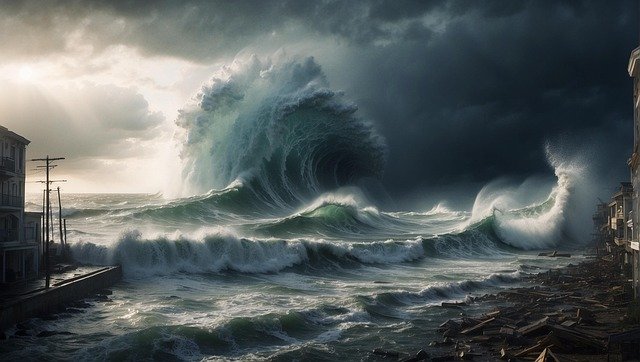Recent headlines have brought tsunamis back into sharp focus. News of an 8.8-magnitude earthquake off Russia’s far east, which triggered tsunami warnings across the Pacific and prompted evacuations in Japan, the US, and beyond, has made many in the UK wonder how such disasters could impact British shores. While the immediate danger was far from the UK, these developments serve as a stark reminder: tsunamis are a global threat, and no coastal nation, including the UK, can consider itself entirely immune.
What is a Tsunami?
A tsunami is a series of powerful, long-period ocean waves caused mainly by earthquakes, but also by underwater landslides, volcanic eruptions, or even meteor strikes. When these waves reach shallow waters near coastlines, they rise dramatically, creating walls of water capable of devastating communities with little warning. Unlike tides, which are driven by the gravitational pull of the Moon and Sun, tsunamis are abrupt and often unexpected, making their effects particularly hazardous for unprepared populations.
Tsunamis in the Global and UK Context
Globally, tsunamis have claimed more than 250,000 lives from 1998 to 2017, with the Indian Ocean tsunami in 2004 alone accounting for over 227,000 deaths. These events demonstrate how destructive tsunamis can be. Still, for those in the UK, the immediate association with tsunamis might seem distant or irrelevant. Yet, history tells a different story.
Contrary to popular belief, the UK is not immune to tsunamis. Geological evidence indicates that around 8,200 years ago, a massive submarine landslide off Norway, known as the Storegga Slide, generated a tsunami that inundated northern Britain, with wave heights reaching up to 30 metres in Shetland. In the southwest, historical records from the 1755 Lisbon earthquake and tsunami detail waves of 2–3 metres smashing into the Scilly Isles and Cornwall. While such events are rare, they are possible and would pose a significant risk to UK coastal communities.
Current Global Tsunami Threats and UK Nationals
The latest surge in tsunami fears comes from an earthquake near Russia’s Kamchatka Peninsula. Initial reports described up to four-metre waves battering parts of the Russian coast and forced mass evacuations in Japan and Hawaii. Following this, the UK Foreign Office promptly issued travel warnings to Britons abroad in regions under threat. The British government’s swift response echoes its past interventions, such as after the Japanese earthquake and tsunami of 2011, when support for nationals was immediate and comprehensive.
Could a Tsunami Hit the UK?
Scientific studies, including research from the British Geological Survey and universities across the UK, suggest the risk of a severe tsunami in Britain is low but not zero. The geography of the British Isles, including a broad continental shelf and the absence of major tectonic plate boundaries nearby, helps reduce the impact of tsunamis compared to countries bordering the Pacific “Ring of Fire”. Most credible scenarios point to the southwest of the country, with Cornwall and the Scilly Isles the most likely to experience hazardous waves if an event were to occur. Simulations of a repeat 1755 Lisbon-type tsunami suggest wave heights of 1–2 metres, with occasional local amplifications of up to four metres in exposed coastal areas.

The Tsunami Warning System: The UK’s Safeguard
The UK takes tsunami preparedness seriously, despite the lower risk. The National Oceanography Centre and the Department for Environment, Food and Rural Affairs (Defra) coordinate the UK’s links to international tsunami warning and monitoring networks. The UK is an active member of UNESCO’s Intergovernmental Coordination Groups and receives alerts from global systems covering the North Atlantic and Mediterranean. Tide gauge stations, monitored by British agencies, keep watch for abnormal sea level changes, feeding data into warning frameworks designed to alert communities rapidly.
Recent innovations, such as the Global Real-time Early Assessment of Tsunamis (GREAT) system, led by Cardiff University, provide hope for better warning and more lives saved. This system uses sound waves to detect tsunamis faster and issue warnings in real time, helping address the potential for short-notice disasters.
Climate Change, Landslides, and Non-Seismic Tsunamis
While most tsunamis are caused by undersea earthquakes, the UK faces unique risks. Landslide-triggered tsunamis, such as those from the ancient Storegga event, remain a theoretical possibility. Some scientists hypothesise that climate change could increase the frequency of these submarine landslides, though this link is still under study. In addition, the UK experiences meteotsunamis—waves generated by rapid changes in atmospheric pressure from storms. These are generally much smaller but can cause unexpected flooding along the southern coast, as occurred in 2011 and again in the Netherlands in 2017.
Building Resilience: UK Government and Scientific Response
After the Indian Ocean tsunami in 2004, which claimed 151 British lives and affected many more, the UK strengthened support networks for nationals abroad and reviewed its own disaster resilience at home and overseas. Expert panels and government agencies now regularly assess coastal hazards. The work of UK-based researchers plays a vital role in safeguarding British citizens both on home soil and overseas, from enhancing flood defences to advancing early warning technologies.
Preparedness and Public Awareness
Awareness and preparedness are crucial for safety. The Environment Agency, alongside local authorities in at-risk regions like Cornwall and the South West, integrates tsunami scenarios into broader flood risk planning. Community engagement includes regular drills, public alerts, and educational campaigns designed to ensure residents understand both the risk and the correct response procedures. Schools in some coastal regions also include lessons about tsunamis as part of geography and science curricula, fostering early awareness.
Conclusion:
It is easy for those living in Britain to consider tsunamis as problems for distant nations. However, from global travel to historic catastrophes, Britons are at least indirectly vulnerable. The combination of strong science, government coordination, and public awareness has kept Britain as safe as possible from these unpredictable threats. As technology advances and climate patterns shift, maintaining and improving this vigilance is crucial for protecting lives at home and abroad. The conversation around tsunamis, sparked by dramatic international events, remains relevant for all of us living on these isles.
